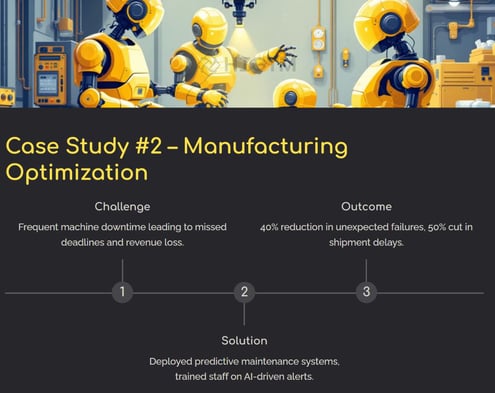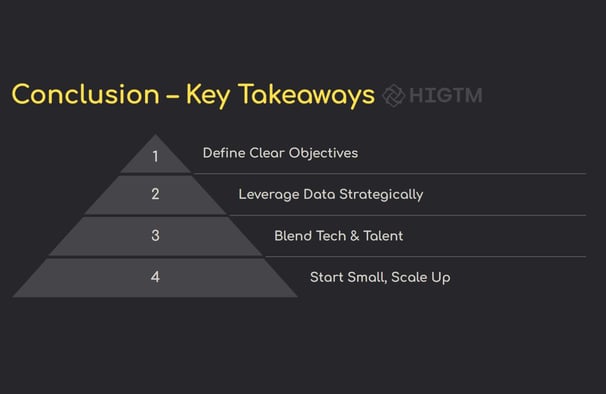16. Inspirational Global Success Stories: How AI and Data-Driven Strategies Transform Businesses Fast
Organizations worldwide are seeking ways to remain competitive, boost growth, and adapt to ever-shifting market conditions. From mid-sized retailers looking to expand online to global manufacturers needing to optimize production, success hinges on the intelligent use of data and innovative strategies. In this comprehensive post, we’ll highlight success stories—quick global case study snapshots—that demonstrate how businesses large and small can harness AI, automation, and forward-thinking leadership to achieve remarkable outcomes. Whether you’re running a small local enterprise or part of an established multinational, these examples serve as a roadmap for what’s possible. By analyzing real-world challenges and solutions, you can identify best practices, adapt them to your context, and catalyze a new phase of growth. Let’s explore some of these exciting success stories in detail.
Q1: FOUNDATIONS OF AI IN SME MANAGEMENT - CHAPTER 1 (DAYS 1–31): CORE AI CONCEPTS & VALUE PROPOSITION
Gary Stoyanov PhD
1/16/20255 min read

1. Reinventing Retail: A Mid-Sized Clothing Store’s Digital Pivot
1.1 The Challenge
A family-owned clothing retailer with multiple brick-and-mortar outlets noticed declining foot traffic and rising overhead costs. While the owners recognized the need to expand online, they were unsure how to compete against major e-commerce players. Stockouts occurred frequently, further damaging brand reputation.
1.2 The Strategy
Personalization via AI: The retailer implemented a data-driven recommendation system that suggested products based on browsing history and past purchases.
Inventory Sync: Real-time integration between online and offline stock provided more accurate availability, reducing stockouts significantly.
Loyalty Program: The company launched a digital rewards platform, encouraging repeat visits and word-of-mouth referrals.
1.3 The Results
Increased Online Sales: Within six months, online revenues grew by 25%.
Better Inventory Turnover: Stockouts dropped by 30%, leading to fewer missed sales opportunities.
Enhanced Brand Image: Customers praised the brand’s personal touch and improved shopping experience.
Key Takeaway: Smaller retailers can compete online by focusing on personalization and supply chain efficiency. AI doesn’t have to be expensive or complicated when the application is carefully targeted, leading to impactful yet cost-effective outcomes.
2. Driving Efficiency in Manufacturing: Predictive Maintenance in Automotive Parts
2.1 The Challenge
A multinational automotive parts manufacturer faced repeated machine breakdowns and delayed shipments. Each unexpected downtime had a ripple effect on production schedules, negatively affecting customer relations and profit margins.
2.2 The Strategy
Predictive Maintenance Platform: By installing sensors on critical machinery, the company monitored temperature, vibration, and performance data to predict potential failures.
Staff Training: Floor managers received training to interpret AI-generated alerts and schedule proactive maintenance.
Automated Reporting: Real-time dashboards tracked production metrics, allowing immediate visibility into issues across multiple plants.
2.3 The Results
Reduced Machine Failures: Unplanned breakdowns dropped by 40%.
Faster Shipping: On-time delivery rates improved, with shipment delays cut by half.
Operational Transparency: Management had a clear line of sight into each stage of production, enabling more strategic planning.
Key Takeaway: Predictive maintenance proves invaluable for any manufacturing outfit aiming to reduce downtime and enhance output. Coupling AI insights with well-trained human operators ensures that digital transformation doesn’t alienate employees but rather empowers them.
3. Modernizing Financial Services: A Regional Bank’s Digital Overhaul
3.1 The Challenge
A regional bank grappled with outdated customer portals and inconsistent service, especially as tech-savvy competitors emerged with sleek mobile apps and quick-turnaround digital solutions. Fraud incidents were also on the rise due to growing online transactions.
3.2 The Strategy
Customer Service Chatbot: Available 24/7, the AI-driven chatbot tackled common inquiries and routed complex issues to live agents.
Single CRM Integration: All customer records and transaction histories merged into a centralized system, enabling a 360° customer view.
Fraud Detection Algorithms: New machine learning tools scanned transaction patterns in real time, flagging anomalies for investigation.
3.3 The Results
Reduced Churn: Better online experience and swift resolutions helped cut customer attrition by 15%.
Revenue Growth: Targeted upselling and cross-selling initiatives improved conversions by 10%.
Security Upgrades: Fraudulent activities saw a sharp decline, boosting overall trust in the bank’s services.
Key Takeaway: Even highly regulated industries like finance can innovate rapidly when they embrace AI tools to enhance user experience and security. By focusing on efficiency and customer-centric solutions, the bank strengthened its reputation as a modern service provider.
4. Elevating B2B Marketing Agencies: AI-Based Lead Scoring
4.1 The Challenge
A small B2B marketing agency struggled to deliver consistent lead quality for its clients. Sales pipelines dragged, and many leads never advanced beyond initial contact.
4.2 The Strategy
Low-Code AI Tools: Instead of hiring a team of data scientists, the agency adopted a lead-scoring platform that used basic AI models to filter out less promising leads.
Automated Follow-Ups: Email sequences triggered by lead score segments helped ensure timely communication.
Culture Shift: Regularly reviewing campaign analytics fostered a learning environment, making continuous improvements possible.
4.3 The Results
Higher Conversion Rates: Lead conversion increased by 20%.
Shorter Sales Cycle: The funnel velocity improved, reducing the time from lead acquisition to closed deal by two weeks.
Employee Satisfaction: Marketers appreciated the data-driven insights, boosting morale and creative thinking.
Key Takeaway: Small agencies can achieve exponential gains by automating time-consuming tasks and using AI for lead qualification. This frees up human teams to focus on higher-value activities like content creation and strategic planning.
5. Common Threads in Success Stories
Despite their different domains, these global success stories share a few overarching themes:
Data Centralization: Unified data repositories allowed real-time visibility and rapid decision-making.
Incremental Implementation: Most projects started small, tested assumptions, and scaled successful pilot results.
Change Management: Training and communication were pivotal. Employees who understood the “why” behind changes adapted more readily and embraced innovation.
Customer-Centric Mindset: Whether it was cutting downtime or improving the shopping experience, solutions that catered to end-user needs consistently yielded stronger performance.
6. Practical Steps to Create Your Own Success Story
Identify Pain Points: Conduct a thorough audit of operational inefficiencies, customer complaints, or growth barriers.
Set Specific Goals: Establish clear KPIs, whether it's reducing stockouts, trimming machine downtime, or boosting conversions.
Choose Scalable Solutions: Opt for user-friendly AI tools, predictive analytics, or automation platforms that can grow with you.
Invest in Training: Equip your workforce with the necessary skills and context to make the most of new systems.
Track & Iterate: Monitor performance closely. If something isn’t delivering as expected, refine processes or pivot to a different approach.
7. Realizing the Potential: Leadership’s Role
Leadership remains the common denominator in all these stories. Without strong executive sponsorship, resource allocation, and an encouraging culture, even the best solution can languish. Leaders must:
Champion Innovation: Model enthusiasm for data-driven processes, praising teams that experiment responsibly.
Allocate Resources Wisely: Ensure sufficient budgets for pilot projects while avoiding overinvestment in untested ideas.
Celebrate Milestones: Acknowledge wins—big or small—to maintain team motivation and foster a culture of continuous learning.
8. Overcoming Adoption Barriers
No business transformation is immune to challenges. Common barriers include:
Budget Constraints: Tackle high-impact use cases first, and start with affordable pilot-scale solutions.
Skill Shortages: Partner with consultants or invest in training to bridge knowledge gaps.
Data Quality & Integration Issues: Prioritize data governance and cleaning at the outset.
Employee Resistance: Communicate transparently and demonstrate quick wins to build trust.
9. Integrating AI, Automation, and Human Insight
A key insight across all these success stories is the balance between technology and human wisdom. AI-driven tools can crunch data and identify patterns at scale, but final decisions—and the nuance of real-life implementation—often benefit from human judgment. Hybrid environments, where machines assist people rather than replace them, frequently yield the best outcomes.
10. Final Thoughts on Achieving Sustainable Success
Innovation is not a one-time project; it’s an ongoing journey. As you glean lessons from these examples, remember that each case thrived by maintaining a long-term perspective, investing in continuous improvement, and staying agile in response to market signals.
To replicate their achievements:
Stay Focused: Prioritize the problem you want to solve and measure everything.
Emphasize Collaboration: Encourage cross-departmental input to foster diverse thinking.
Aim for Resilience: Build strategies that can adapt to evolving customer expectations, market shifts, or technological advancements.
Get started with a Private Counseling Session at HIGTM.com.
Let’s collaborate to pinpoint the best opportunities and transform them into tangible growth and success for your business.




Turn AI into ROI — Win Faster with HIGTM.
Consult with us to discuss how to manage and grow your business operations with AI.
© 2025 HIGTM. All rights reserved.
